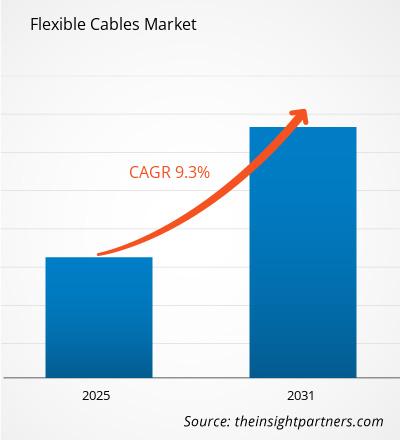The Flexible Cables Market is expected to register a CAGR of 9.3% from 2025 to 2031, with a market size expanding from US$ XX million in 2024 to US$ XX Million by 2031.
The report is segmented by Application (Power transmission, Signal transmission); End User (Electronics appliances industry, Automobile industry, Energy and utilities, Telecommunication). The global analysis is further broken-down at regional level and major countries. The Report Offers the Value in USD for the above analysis and segments.
Purpose of the Report
The report Flexible Cables Market by The Insight Partners aims to describe the present landscape and future growth, top driving factors, challenges, and opportunities. This will provide insights to various business stakeholders, such as:
- Technology Providers/Manufacturers: To understand the evolving market dynamics and know the potential growth opportunities, enabling them to make informed strategic decisions.
- Investors: To conduct a comprehensive trend analysis regarding the market growth rate, market financial projections, and opportunities that exist across the value chain.
- Regulatory bodies: To regulate policies and police activities in the market with the aim of minimizing abuse, preserving investor trust and confidence, and upholding the integrity and stability of the market.
Flexible Cables Market Segmentation
Application
- Power transmission
- Signal transmission
End User
- Electronics appliances industry
- Automobile industry
- Energy and utilities
- Telecommunication
You will get customization on any report - free of charge - including parts of this report, or country-level analysis, Excel Data pack, as well as avail great offers and discounts for start-ups & universities
Flexible Cables Market: Strategic Insights

-
Get Top Key Market Trends of this report.This FREE sample will include data analysis, ranging from market trends to estimates and forecasts.
Flexible Cables Market Growth Drivers
- Sustainability and Eco-Innovation Imperative: Increasing global environmental consciousness is compelling industrial design sectors to prioritize sustainable product development. Companies are integrating circular design principles, recyclable materials, and energy-efficient manufacturing processes. This driver encourages designers to create products that minimize environmental impact, reduce carbon footprints, and align with stringent ecological regulations, transforming traditional design paradigms toward more responsible and resource-conscious approaches.
- Digital Transformation and Advanced Technologies: Rapid technological advancements like artificial intelligence, augmented reality, and advanced computational design tools are revolutionizing industrial design processes. These technologies enable more sophisticated, precise, and innovative design methodologies, allowing designers to simulate complex scenarios, optimize product performance, and accelerate prototype development through advanced computational modeling and immersive visualization techniques.
Flexible Cables Market Future Trends
- Advancements in Cable Materials and Technology : The development of new materials such as Teflon, rubber, silicone, and high-performance plastics has significantly improved the flexibility, durability, and heat resistance of cables. These innovations are making flexible cables more reliable, lightweight, and long-lasting, which expands their use across various industries.
- Miniaturization and Lightweight Designs: Another significant trend is the miniaturization of flexible cables, driven by the need for smaller, lighter, and more compact devices. As electronic devices become more portable and compact, the cables used within them must also be reduced in size without compromising performance. Flexible cables are becoming thinner, lighter, and more efficient to meet these design requirements. In sectors such as consumer electronics, medical devices, and automotive, this trend is critical to enabling the development of smaller, high-performance products. The trend toward miniaturized flexible cables is expected to continue as consumer and industrial applications demand increasingly compact and powerful devices.
Flexible Cables Market Opportunities
- Growing Infrastructure Development: Flexible cables are essential for the construction of modern buildings and smart infrastructure. These cables are used for wiring electrical systems, lighting, power distribution, and communication networks within commercial and residential buildings. Flexible cables are ideal for areas where cables need to be routed through tight spaces or moved frequently.
- Expansion in Industrial Automation and Robotics: Industrial automation and robotics are rapidly expanding across sectors like manufacturing, automotive, healthcare, and logistics. The need for flexible cables in these industries is driven by their ability to support highly dynamic operations involving constant movement, bending, and twisting, such as robotic arms, automated conveyor systems, and factory machinery. As industries adopt more automated systems to improve efficiency and productivity, the demand for flexible cables designed for high-durability, high-performance, and safe operation in these environments is set to grow. The ongoing investment in automation and smart factories provides a lucrative opportunity for manufacturers of flexible cables to cater to this rising demand.
Flexible Cables Market Regional Insights
The regional trends and factors influencing the Flexible Cables Market throughout the forecast period have been thoroughly explained by the analysts at The Insight Partners. This section also discusses Flexible Cables Market segments and geography across North America, Europe, Asia Pacific, Middle East and Africa, and South and Central America.
Flexible Cables Market Report Scope
| Report Attribute | Details |
|---|---|
| Market size in 2024 | US$ XX million |
| Market Size by 2031 | US$ XX Million |
| Global CAGR (2025 - 2031) | 9.3% |
| Historical Data | 2021-2023 |
| Forecast period | 2025-2031 |
| Segments Covered |
By Application
|
| Regions and Countries Covered |
North America
|
| Market leaders and key company profiles |
|
Flexible Cables Market Players Density: Understanding Its Impact on Business Dynamics
The Flexible Cables Market is growing rapidly, driven by increasing end-user demand due to factors such as evolving consumer preferences, technological advancements, and greater awareness of the product's benefits. As demand rises, businesses are expanding their offerings, innovating to meet consumer needs, and capitalizing on emerging trends, which further fuels market growth.

- Get the Flexible Cables Market top key players overview
Key Selling Points
- Comprehensive Coverage: The report comprehensively covers the analysis of products, services, types, and end users of the Flexible Cables Market, providing a holistic landscape.
- Expert Analysis: The report is compiled based on the in-depth understanding of industry experts and analysts.
- Up-to-date Information: The report assures business relevance due to its coverage of recent information and data trends.
- Customization Options: This report can be customized to cater to specific client requirements and suit the business strategies aptly.
The research report on the Flexible Cables Market can, therefore, help spearhead the trail of decoding and understanding the industry scenario and growth prospects. Although there can be a few valid concerns, the overall benefits of this report tend to outweigh the disadvantages.
Frequently Asked Questions
What are the options available for the customization of this report?
What are the deliverable formats of the Flexible Cables market report?
What are the future trends of the Flexible Cables market?
What are the driving factors impacting the Flexible Cables market?
What is the expected CAGR of the Flexible Cables market?
- Historical Analysis (2 Years), Base Year, Forecast (7 Years) with CAGR
- PEST and SWOT Analysis
- Market Size Value / Volume - Global, Regional, Country
- Industry and Competitive Landscape
- Excel Dataset
Recent Reports
Testimonials
Reason to Buy
- Informed Decision-Making
- Understanding Market Dynamics
- Competitive Analysis
- Identifying Emerging Markets
- Customer Insights
- Market Forecasts
- Risk Mitigation
- Boosting Operational Efficiency
- Strategic Planning
- Investment Justification
- Tracking Industry Innovations
- Aligning with Regulatory Trends





















 Get Free Sample For
Get Free Sample For